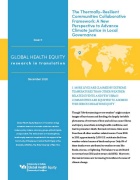Issue 11: The Thermally-Resilient Communities Collaborative Framework: A New Perspective to Advance Climate Justice in Local Governance
Global Health Equity Research in Translation brings academic research to broader audiences: decision makers, policy makers, advocacy groups, philanthropists, and journalists. The series draws on transdisciplinary health equity research completed with the support of the Community of Excellence in Global Health Equity at the University at Buffalo, The State University of New York.
I. MORE LIVES ARE CLAIMED BY EXTREME TEMPERATURES THAN OTHER WEATHER-RELATED EVENTS, AND FEW URBAN COMMUNITIES ARE EQUIPPED TO ADDRESS THIS SERIOUS HEALTH INEQUITY
Though “life-threatening severe weather” might conjure images of hurricanes and flooding, the largely invisible phenomena of extremes of heat and cold can cause illness and injury, exacerbate existing health conditions, and lead to premature death: thermal extremes claim more lives than all other weather-related events. From 2006 to 2010, approximately 2,000 U.S. residents died from weather-related causes of death each year. Only 6% of these deaths were attributed to weather events like floods, storms, or lightning. The balance was attributed to extreme heat (31%) and extreme cold (63%). Moreover, thermal extremes are increasing in incidence because of climate change.
Numerous studies have found that in the US, extreme heat events lead to disproportionate incidence of injury, illness, and death among historically disenfranchised populations. The inequitable impact is thought to be attributable to social determinants of health, including lopsided access to resources such as healthy housing, safe drinking water, and nourishing food. An additional factor could be the “microclimates” within a given urban area that are produced through the interaction of weather events and “urban forms” such as buildings that block or channel wind, and tree canopies that provide shade. Less well studied than severe heat is the impact of extreme cold events, which produce mortality rates equal to or greater than extreme heat events. According to the CDC, deaths from hypothermia outnumbered deaths from hyperthermia in all but one year between 1999 and 2015.
At the local level, the potential impact of climate-change related extreme temperatures on communities must be anticipated in local planning and response efforts. Such efforts should identify key responders and delineate responsibilities for governmental agencies and community based organizations (CBOs). Communication and coordination among public agencies and CBOs is necessary to share information, identify gaps, and spot opportunities for cross-sectoral collaboration. To that end, in a recent publication, an interdisciplinary team of scientists led by Zoé Hamstead sets forth a framework for planning and test-bed design phases of local thermal management systems. [i]
In their “Thermally Resilient Communities Collaborative” (TRCC) framework, Hamstead and her colleagues have devised an approach that engages local actors in the identification of built environments and behaviors that create hazardous thermal conditions; elevates the experiences of vulnerable, marginalized communities; and develops effective means of communicating information about microclimates and community members’ subjective experiences with thermal discomfort to responders and prevention planners.
The risks engendered in thermal extremes arise from community, household, and individual processes and actions that shape the physical and social character of a neighborhood; communities’ access to cooling or warming facilities and other assistance; and base-level public health and wellbeing. The cross-sectoral nature of these factors and the professionals who consider them to be in their purview reveal important opportunities, including identification of service and data gaps, and system-level, multi-sectoral collaboration.
II. PRACTICAL TAKEAWAYS
- Climate change is by definition a global problem that urgently requires decisive, cooperative, and international action. While a unified, transnational approach to carbon emission reduction is required, the immediate and ongoing consequences of climate change must be anticipated in local planning.
- As a consequence of climate change, temperature extremes can be expected to accelerate in frequency and severity. Because thermal extremes claim more lives than any other weather-related phenomenon, they merit particular attention by policy makers, planners, and local agencies that provide disaster relief and aid to distressed community members.
- Vulnerable, historically marginalized populations are disproportionately affected by extreme thermal events.
- Existing objective temperature measures do not capture individuals’ lived, subjective experiences of thermal discomfort, which are crucial predictors of increased stress and physical health risk.
- While certainly understanding social determinants of health to bear on thermal threat, the TRCC reconceptualizes thermal threat by making larger points about the need for collective action that reorients policy, planning, governance models, and coordination efforts across sectors. Meaningful interventions also require an intersectoral approach, as thermal insecurity is tied to mobility injustice, housing injustice, energy injustice, and environmental injustice. Thus, transportation management, for example, is rightly also understood as a thermal management in that transit spaces are either designed – or not designed – to be thermally protective.
- The TRCC incorporates these newly considered foci: (a) thermal risk distribution across communities; (b) subjective experiences of thermal discomfort; and (c) intersectional dimensions of vulnerability to thermal discomfort, including human physiology, the built environment, and health and social inequities.
III. POLICY TAKEAWAYS
- The TRCC describes how governance networks can be utilized to respond to extreme thermal events by identifying and integrating new data, technology, and capacities.
- The TRCC can be used to hypothesize ways in which policy and collective collaboration can be improved to manage thermal extremes.
- Local planners, policy makers, and community leaders can utilize the TRCC to facilitate information sharing; identify current practices; reveal data and service gaps; and create opportunities to engage in cross-sectoral, collaborative management of extreme thermal events.
Acknowledgements
The information in this policy brief was extracted from Hamstead, Zoé et al. (2020). Thermally resilient communities: creating a socio-technical collaborative response to extreme temperatures. Buildings & Cities, 1(1), pp. 218-232. DOI: https://doi.org/10.5334/bc.15
Author
Dr. Lisa Vahapoğlu
Recommended Citation
Vahapoğlu, Lisa. A New Tool to Advance Climate Justice in Local Governance: The Thermally-Resilient Communities Collaborative Framework. Global Health Equity Research in Translation. Eds. Hamstead, Frimpong Boamah, Kordas, and Raja. Community of Excellence in Global Health Equity, December 2020.
Source Text
Hamstead, Zoé et al. (2020). Thermally resilient communities: creating a socio-technical collaborative response to extreme temperatures. Buildings & Cities, 1(1), pp. 218-232. https://doi.org/ 10.5334/bc.15
Series Editors
Dr. Emmanuel Frimpong Boamah, Dr. Katarzyna Kordas, and Dr. Samina Raja
Design and Production
Nicole Little and Jessica Scates
FOOTNOTES
[i] Hamstead, Z., Coseo, P., AlKhaled, S., Frimpong Boamah, E., Hondula, D. M., Middel, A., and Rajkovich, N. (2020). Thermally resilient communities: creating a socio-technical collaborative response to extreme temperatures. Buildings and Cities, 1(1), pp. 218-232. DOI: https://doi.org/10.5334/bc.15

